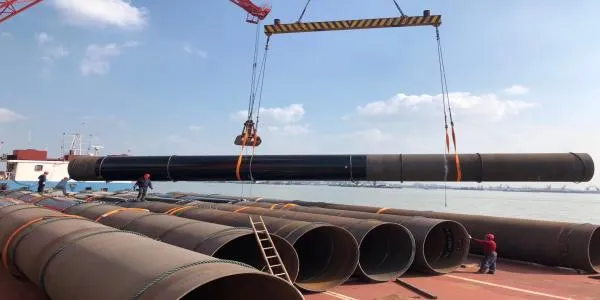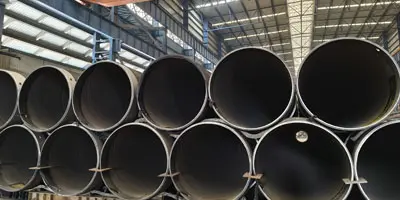Piling pipe is mainly used in building foundation engineering to increase the bearing capacity of the ground and make the building structure more stable. Piling pipe is widely used in natural gas, petroleum, chemical industry, electricity, heat, water supply and drainage, steam heating, hydropower station, thermal power generation, water source and other long-distance transportation, bridges, steel structure and other engineering fields. There are many options in terms of structural support. This includes concrete piles, steel sheet piles and wooden piles. The types of steel pipes for piling pipe include SSAW steel pipe, LSAW steel pipe. Due to the customizability and affordability of steel pile pipe, it has become the most popular choice.
Unlike other options, Piling pipe in piled pipe are pre-built structures that are hammered into the ground and held in place by friction with the soil. Not only are these structures able to efficiently handle heavy structural loads, but they can also be adjusted to suit project needs by adding or removing pipes.

Production process of piling pipe
(1) Raw materials are strip steel coil, welding wire and flux. They must undergo strict physical and chemical inspection before being put into use.
(2) The strip steel is butt-jointed head and tail by single-wire or double-wire submerged arc welding. After being rolled into steel pipe, automatic submerged arc welding is used for repair welding.
(3) Before forming, the strip steel is leveled, trimmed, planed, surface cleaned, conveyed and pre-bent.
(4) An electric contact pressure gauge is used to control the pressure of the oil cylinder on both sides of the conveyor to ensure the smooth conveying of the strip steel.
(5) Externally controlled or internally controlled roller forming is adopted.
(6) A weld gap control device is used to ensure that the weld gap meets the welding requirements. The pipe diameter, misalignment and weld gap are strictly controlled.
(7) Both internal and external welding are performed by single-wire or double-wire submerged arc welding with the American Lincoln electric welder to obtain stable welding specifications.
(8) The welds are all inspected by online continuous ultrasonic automatic flaw detector to ensure 100% non-destructive testing coverage of spiral welds. If there are defects, the alarm will be automatically sounded and the mark will be sprayed. The production workers can adjust the process parameters at any time to eliminate the defects in time.
(9) Use air plasma cutting machine to cut the steel pipe into single pieces.
(10) After cutting into single steel pipes, the first three steel pipes of each batch must undergo a strict first inspection system to check the mechanical properties, chemical composition, fusion status, surface quality of the steel pipe and non-destructive testing of the welds. Only after ensuring that the pipe making process is qualified can it be officially put into production.
(11) The parts with continuous ultrasonic flaw detection marks on the welds are manually ultrasonically and X-rayed for review. If there are defects, they are repaired and then subjected to non-destructive testing again until it is confirmed that the defects have been eliminated.
(12) The pipes where the strip butt welds and the T-joints intersecting with the spiral welds are all inspected by X-ray television or film.
(13) Each steel pipe is subjected to a hydrostatic pressure test, and the pressure is radially sealed. The test pressure and time are strictly controlled by the steel pipe water pressure microcomputer detection device. The test parameters are automatically printed and recorded.
(14) The pipe ends are machined to accurately control the end face verticality, groove angle and bell edge.
Surface treatment and transportation protection of piling pipe
After the production of steel pipes is completed, the surface of the steel pipes is simply coated according to customer requirements to prevent rust. Common coatings include black paint, varnish, and anti-rust oil. These materials can play a temporary anti-rust effect during transportation.
Some manufacturers will affix barcodes after the production of piling pipes is completed. The barcode is equivalent to the ID card of each unit's steel pipe, which records the furnace number, pipe number, steel grade and other materials and production information of the steel pipe. After completing the coating process, the production workers of the oiling process will obtain the corresponding production information by scanning the barcode, and spray the label according to the standards and contract requirements to ensure the traceability of the product.
Generally speaking, the packaging of the product plays a vital role in the protection of the product during transportation. According to the size, coating, processing type, etc. of the steel pipe, the factory usually uses pipe caps, PVC wrapping cloth, nylon slings, galvanized belts, fumigated wood and other materials to protect the steel pipe. At the same time, our engineers can also customize more solid, stable and easy-to-load and unload product packaging design solutions according to customer requirements.
Application of piling pipe in docks
Recently, the project of using pile pipes in Shatin, Dongguan, China has been perfectly completed. This project is the largest and highest berthing grade deep-water container dedicated dock ever built. The spacing of the dock pile foundation is 9.0m, with 7 foundation piles in each row, a total of 784 dock pile foundation steel pipe piles. All pile foundations are Φ1200mm steel pipe piles, and the pile foundation uses medium-weathered siltstone as the bearing layer. The successful completion of the construction of the first trial pile marks a new starting point for the pile foundation project of the dock structure. The completion of this pile pipe project is not only a solid guarantee for achieving the annual output value target, but also a key link in promoting the high-quality development of the project and building a brand project. The realization of this important node not only lays a solid foundation for the smooth progress of the subsequent dock superstructure construction and pile clearance work, but also promotes the construction process of pile foundation and dock superstructure in a high-quality and efficient manner. In the future, we will uphold the spirit of craftsmanship, create high-quality projects, green projects, and clean projects, promote project construction with high quality and efficiency, and contribute to the creation of a new modern port.
Through the above measures, piling pipes have shown excellent performance and reliability in various engineering projects and have become an important material in modern engineering construction. Therefore, through the characteristics and applications of piling pipes explained above, we hope that everyone can better understand and use piling pipes reasonably, thereby improving the quality of construction.






 English
English Español
Español بالعربية
بالعربية











 Phone :
Phone :  Whatsapp :
Whatsapp :  Email :
Email : 


